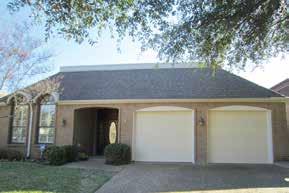
10 minute read
Neighborhood Rights
The Changing Face of Prairie Creek and Canyon Creek. Neighbor’s rights, Is it really a thing?
by Maria Harris
It’s December, 2002. After 18 months of house hunting, I finally found a house that felt like “home”, the minute I walked into it. It needed some work, but I could live with updating it over time. I remember saying to my husband, “if you can make the outside look as good as the inside, I have found our family’s new home”. That was my introduction to Canyon Creek. I fell in love with the topography, the lot sizes, and the character of the different styles of homes. I was so impressed with the schools, parks and the overall neighborhood feel. I remember describing it to my family out of state as a small town feel 15 minutes from downtown Dallas. I will never forget our first summer at the Canyon Creek neighborhood pool. I met so many people that summer, it reminded me of my first year of college!
Fast forward 13 years. After the drop in the new build construction market of 2006 and the financial slide of the housing (mortgage) market of 2007, developers started popping up all over Richardson- especially Prairie Creek to “redevelop”. Before we knew it, modest custom homes built circa 1960’s were being purchased, scraped to their foundation and new 4,000-5,000 SF enormous homes replaced them. The first few were surprising, but didn’t really cause great concern among the overall neighborhood. However, as more developers showed up and snatched up properties, those few homes turned into more than 50 and have continued to grow in number. As new home after new home has been built, some major issues have surfaced in the neighborhood.
As the “knock downs” continued to grow in number so did the room additions and full home renovations. For homeowners who appreciated the original development of the neighborhood, with its architectural diversity, topography, etc. they hired remodeling contractors to grow their space and/ or bring it into the 21st century.
When there is a building and/or remodeling “boom” in an area, there are positive and negative issues that are created from this situation. To name some of the positive: property values increase, neighborhoods regenerate with younger families giving life to the schools and parks, properties are well maintained and there is a renewed sense of pride about where you live. The flip side of that shows some very negative attributes: construction debris left strewn about, contractors parking everywhere- disrespecting neighbors’ property, loud music all hours of the day.
These negative issues are just a few related to the actual job site. A bigger problem has surfaced. It has been coined “Disrespectful Redevelopment”. This is where builders/ remodelers and their design teams as well as architects design and build a home or remodeled space that takes absolutely no consideration into effect the original design of the neighborhood, the deed restrictions of the neighborhood and original builders, and quality of the use of space of the neighbors’
at the adjacent properties. These issues have become a hot topic at many HOA meetings, luncheons and neighborhood gatherings. It has permeated the core of our community.
Concerned residents and neighborhood leaders who have studied this issue, have identified 3 key issues as being the most prevalent.
Problem I.
Window Placement. The original 20+ custom builders in
Richardson, designed the homes to have most of their windows on the east side of the home and few or no windows on the west side. This allowed for the backyards of the properties to be private.
Even though in the 60’s the yards either had no fencing or chainlinked fencing, windows from the neighbor’s home did not peer into your backyard. Architects & Developers are designing these new homes with windows on the west side, which obliterates any sense of privacy the neighbors previously had.
In a perfect (or neighborly) world, the new build would use transomstyle windows or frosted windows that overlook the neighbor’s yard or private spaces. If this were happening, it would not be a hot issue.
Problem II.
Deed Restriction Violation- Front Facing Garage. The Deeds attached to the properties in much of Richardson require that a house is not allowed to have a front facing garage; this is particularly true in most of Canyon Creek, and most neighborhoods that have alley access. Therefore, front facing garages are in many cases a
DEED VIOLATION. So, why does the City of Richardson approve the plans and permits to build homes with front garages? The answer is: The City enforces code violations, not deed restrictions. To have legal standing contest a deed restriction violation, you must live in the legal subdivision where the violation exists. Note Canyon Creek is composed of over 20 of these subdivisions, and while most share the same restrictions, there are exceptions.
Problem III.
Fences and retaining walls. A retaining wall does not count towards the height of a fence.
Per the COR website: “Retaining walls over 4 ft. in height, measured from the bottom of the footing to the top of the wall, require a permit and must be designed by a licensed professional engineer. Richardson’s Comprehensive Zoning Ordinance limits fences to a maximum height of 8 ft. from the rear property line to the front wall of the house.”
Staying within City Code guidelines, we see builders/ contractors building 4’-5’ retaining walls and then 8’ fences on top of the retaining walls. This becomes, in essence, a 12’-13’ wall. The neighbor’s 1 story ranch home, with their eves at 8’ basically looks at a fence that extends 4’-5’ above the eve of their roof, never experiencing sunlight in that area of their property again.
These issues to name a few, are quite real to the existing and often long-time residents of Richardson who choose not to sell their home to a builder to be knocked down. Today there is no legal recourse (other than that for a deed restriction discussed above) for residents to preserve their privacy and sight lines.
Prairie Creek, Canyon Creek, Cottonwood Creek and the Indian Reservation are unique in that they do not have mandatory Home Owners Associations (HOAs). If they did, many of these issues would be resolved through zoning restrictions (HOAs cannot control Zoning) adopted by the HOA. Mandatory HOAs regulate shingle style and color, house color, fences, windows, just to name a few items. Those of us who live in these areas of Richardson, have most likely appreciated over the years, that we didn’t have an HOA regulating every little thing we wanted to do to the exterior of our home. It is because we do not have mandatory HOAs, that the problems listed above are actually exacerbated issues today.
The Canyon Creek HOA Board took the time a year ago, to invite several of the neighborhood builders/ developers to an open discussion and possible solution to these issues. Four of them attended the meeting, were very professional and willing to enter into a dialogue. The developers explained that if there were city codes in affect that addressed these issues, they would follow the code requirements. However, if these issues are not codified, they would not voluntarily impose them on their clients. They did not want to risk the client’s satisfaction or sale of the property. They suggested a guide for redevelopment from the City of Richardson. However a guide is not the same as city code, and there is no recourse for not following a guide. If the City of Richardson codifies these issues, then there would be a new standard, enforceable by Community Services and any requests for exceptions could go through one of the existing boards, or a newly formed board for handling variance requests.
A current example of such a code is garage conversions. In January 2004 the City of Richardson amended the Comprehensive Zoning Ordinance to require 2 parking spots in an enclosed area. With the goal of reducing the number of carports constructed on residential properties the argument was made (and passed) that carports reduced property values. Therefore, if an attached garage was converted into a living space, the homeowner would be required to replace the enclosed parking with another garage. A carport was no longer a viable option because it is not “enclosed”. This has caused quite a raucous in Richardson, but the amendment was passed, so now it is code. If a resident needs a variance to this code, the city has an open public process for this to be considered.
So, now what?
We know there is a problem and the problem is causing dissention in the neighborhood(s). The resentment is creating tension and a divisiveness that is driving neighbors away from one another instead of drawing them together. The developers are trying to make a living. So long as there are properties to buy and redevelop, they will remain in Richardson. The city officials are trying to do their job (they are not the bad guy here). May I remind you that the City of Richardson is still by far one of the best cities to live in. Our City Council, City Management and Community Services Department are hard- working, forward thinking advocates for the best possible Richardson. I have my issues, but I try to remind myself of that every day. In my line of work, I deal with different cities around the Dallas area. The City of Richardson is by far the most organized, most professional and most concerned about their homeowners than any of our neighboring cities.
I submit to you, our individual responsibility is to be the best possible neighbor we can be. Check on our elderly neighbors: help them with their lawn or any simple issues around their home. Invite your neighbors over for a visit. Plan some time at the park with another family or two. Let us not allow our frustrations change who we are as a community. I want to share a quick story with you about the kind of neighborhood I live in (Canyon Creek).
This past Halloween, instead of dressing up and sitting on my front porch to hand out candy while my husband takes our youngest sons trick-or-treating, I decided to do something different. With the help of some of our friends and teenagers from our church (The Heights Baptist Church), we assembled 4 carnival games on our front yard and we all dressed up for the fun. We always have lots of kids come by because of our location (and our street goes a little crazy over Halloween), but I never expected the turn out we had. Our yard was covered with kids! We laughed, and played. I met so many new people, it was just like that first summer at the pool. We handed out over 800 pieces of candy! One younger woman approached me towards the
end of the night and said to me, “I just had to come back and tell you, my husband and I are renting in the neighborhood because we weren’t sure where we wanted to live, but this cinched it. I want to live in this neighborhood and on this street. I have never seen anything like this community in my entire life!” With tears in my eyes, I just gave her a hug and said welcome to the neighborhood!
That is the neighborhood we purchased our house in. The neighborhood we are raising our 4 boys in. We love this neighborhood and our community. We don’t need to be divisive and polarizing. If you are concerned about these “disrespectful redevelopment” issues, or you have had a personal experience regarding one of them, please consider sharing it briefly in a note or email to your City Councilperson. I am not advocating bombarding our city officials. As my mother always said, “you get more with sugar than you do with salt”. Just share your story and/or your concern briefly, it may just help our City Council pass some new city codes that help our neighborhoods honor the privacy and respect we have had for more than 50 years.

Respectful Redevelopment Sight lines preserved


Respectful Redevelopment Hip roof on side, and 2nd story centered in home










